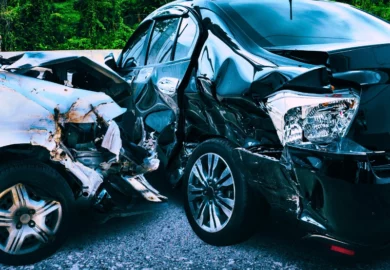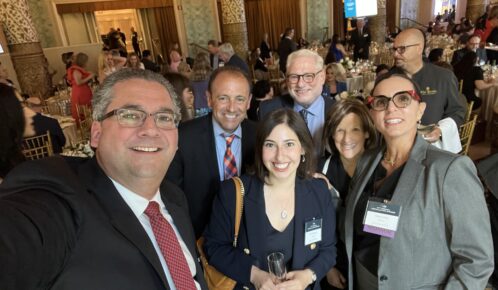Much of the time, you can file a claim in Chicago for passenger injuries in T-bone accidents. The process likely will get complicated quickly. It involves investigating the crash, preserving evidence, identifying liable parties, negotiating with insurers, and, if necessary, preparing for trial. All this is on top of dealing with injuries from the crash.
Table of Contents

A car accident lawyer for passengers can streamline the process and fight for the compensation you need. Call Ankin Law at 312-600-0000.
Who Is Liable for Passenger Injuries in a T-Bone Crash?
An early step in getting compensation is figuring out liability. In any car crash, including T-bone accidents, liability can fall on one or more parties.
The Driver of the Car In Which You Rode
In some cases, the driver of the vehicle you were in may have acted negligently, perhaps by failing to yield, driving distracted, or running a red light. Filing a case for compensation may be difficult if the driver is someone you know or care about, such as a family member or friend. However, for the most part, claims are filed with the person’s insurance company and not against the person directly.
The Driver of the Other Vehicle
Another driver may be liable for the passenger injury in a T-bone accident, perhaps due to ignoring traffic signals, speeding through an intersection, or driving intoxicated. In 2023, about 18% of Chicago traffic deaths involved a driver running a red light or stop sign. Passengers have the right to file claims against a party whose negligence contributed to the collision.
Shared Fault
Shared responsibility factors into some T-bone accidents, with both drivers’ insurance companies sharing the costs of a claim. Modified comparative negligence applies in Illinois and gives you the ability to recover damages as long as you are less than 51% at fault. Passengers are rarely at fault.
Vehicle Manufacturers or Government Entities
In a few cases, liability for passenger injuries in T-bone accidents extends to parties such as vehicle manufacturers or government entities. This could occur with vehicle defects that worsened your injuries. For example, a failed side airbag or faulty brakes could have made your injuries much worse. The same idea applies for an intersection that the city of Chicago maintained or designed badly.
What Passengers Should Know About Filing an Injury Claim
After passenger injuries in four common types of car accidents, you may want to seek compensation for medical bills, lost wages, pain and suffering, and long-term care. In Illinois, the law recognizes that passengers are almost never responsible for causing a collision. You can file a claim against the at-fault driver’s insurance or pursue multiple claims if you believe more than one party is liable. To file a claim after a T-bone crash, keep these steps in mind:
Negligence and Causation
Injured passengers should show that someone’s negligence caused the accident and that the accident caused the injuries. Proving this typically requires gathering:
- Police reports
- Witness statements
- Footage from traffic cameras
- Medical records
- Accident reconstruction analysis
A car accident lawyer can be a huge help. Attorneys for passengers can collect evidence, handle insurance adjusters, and build a strong case.
Filing Deadlines
The statute of limitations typically gives you two years from the date of the accident to file a claim after passenger injuries in a T-bone crash. Act quickly, because evidence can disappear or become harder to gather as time passes.
Compensation from Multiple Insurance Policies
More than one insurance policy might cover you. Possibilities include the driver’s insurance policy, the at-fault driver’s insurance, your own personal injury protection (PIP) coverage, or uninsured/underinsured motorist coverage. Figuring out multiple insurance policies and coverage limits can be overwhelming. This is one reason working with a car accident lawyer can be so helpful.
Caution With Insurance Adjusters
Insurance adjusters may seem sympathetic and like they have your best interests in mind. Tread carefully. An adjuster’s job is to minimize payouts, and insurance companies are for-profit businesses. They often offer quick settlements that fail to account fully for medical bills, future treatment, and potential long-term effects of injuries. Before you sign anything for passenger injuries in T-bone accidents, consider speaking with an attorney.
Why You Should Speak With a Car Accident Lawyer After a T-Bone Collision
T-bone collisions often cause severe injuries, especially to passengers on the side of impact. Injuries may include traumatic brain injury, spinal cord damage, broken bones, internal organ trauma, PTSD, and anxiety. The stakes could be even higher if you are hurt enough to ask yourself, “What if I get a permanent disability after a car accident?”
A Lawyer Can Assess the Value of Your Claim
It is easy to underestimate the full cost of passenger injuries in T-bone accidents. Medical expenses are just one part of the equation. A car accident lawyer for passengers can help you assess past and future medical treatment, lost wages, loss of future earning potential, pain and suffering, emotional trauma, loss of enjoyment of life, and other considerations.
A Lawyer Can Navigate Chicago’s Legal Processes
Many people are unfamiliar with what to expect during a Chicago car accident case. Lawyers can help keep legal procedures, court filings, and negotiation tactics from becoming overwhelming for you. Lawyers investigate the crash, collect and preserve evidence, file insurance claims, negotiate with insurers, and prepare for trial, if necessary. They can help you avoid common mistakes, such as missing deadlines, making incorrect statements, and accepting inadequate settlements.
It Makes a Lot of Sense Financially
Most personal injury lawyers in Chicago work on a contingency fee basis. They get paid only if you do. This gives them an incentive to advocate the best they can for you. It also means minimal or no financial risk to you. Contact us today at Ankin Law to discuss possible next steps.



